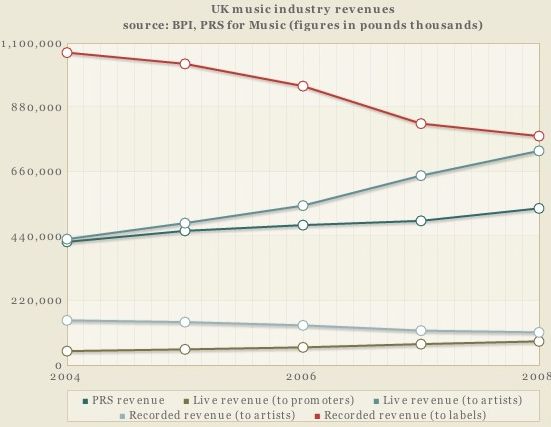
via the Times UK:
This is the graph the record industry doesn’t want you to see.
It shows the fate of the three main pillars of music industry revenue – recorded music, live music, and PRS revenues (royalties collected on behalf of artists when their music is played in public) over the last 5 years.
We’ve broken each category into two sub-categories so that, for any chunk of revenue – recorded music sales, for instance – you can see the percentage that goes to the artist, and the percentage that goes elsewhere. (In the case of recorded music, the lion’s share of revenue goes to the record label; in the case of live, the promoter takes a cut etc.)
Hopefully, this analysis – and there’s more on the nuts and bolts of our method below – sheds some factual light on the claims and counter-claims that are paranoically sweeping across the music industry establishment, not least that put forward by the singer Lily Allen in this paper recently – and the BPI – that artists are losing out as a result of the fall in sales of recorded of music.
The most immediate revelation, of course, is that at some point next year revenues from gigs payable to artists will for the first time overtake revenues accrued by labels from sales of recorded music.
Why live revenues have grown so stridently is beyond the scope of this article, but our data – compiled from a PRS for Music report and the BPI – make two things clear: one, that the growth in live revenue shows no signs of slowing and two, that live is by far and away the most lucrative section of industry revenue for artists themselves, because they retain such a big percentage of the money from ticket sales.
The long and short of it – the music industry’s “decline” isn’t as simple as record labels would like us to believe, and that musicians are getting a bigger slice of the music industry pie than they have in the past.

Revenue from performances and selling scores has long been how musicians made money. The invention and commercialization of recording technologies represents a tiny time-slice in the history of music.
Perhaps the anomaly was the period of time during which musicians made much of their money from recordings.
A related issue: BMI and ASCAP fees are so high (and strict) that more and more venues are putting an end to having live music. In my opinion, this is in fact BAD for artists. If the policies were relaxed, then more artists could perform and make a living, even a meager one. Unfortunately the only artists that these organizations are protecting are the artists that have already met significant success with their music – and their record companies, and their agents, etc., etc. Those of us still in the trenches are being held down by these performing rights organizations – and it really needs to be re-examined. They claim to be looking out for the best interests of artists – but only the rich ones!!! Class action lawsuit, anyone?
It would definitely be interesting to see a similar study of the music industry in America, and then compare it with this UK study.